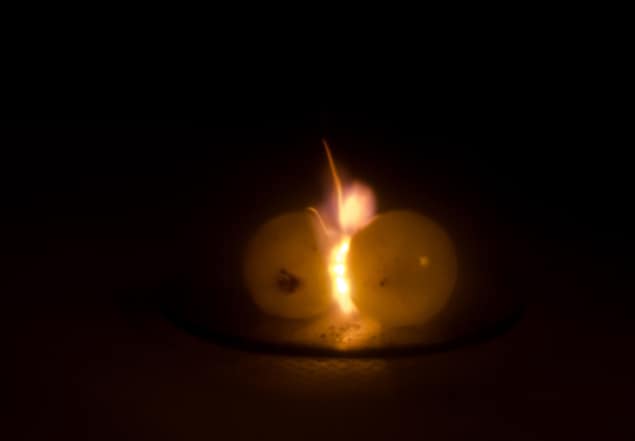
YouTube videos of grape halves sparking in a household microwave oven and igniting a plasma have amassed millions of views, but the physical mechanisms behind this phenomenon are in fact little understood. Thanks to thermal imaging experiments and finite element simulations, a team of researchers in Canada has now discovered that the grapes form resonant cavities at their centres that concentrate microwaves to much smaller wavelengths, which leads to the creation of the plasma. The observations, which are usually only seen in nanoscale metallic objects, could be useful for experimental research in nanophotonics.
The “grape plasma” phenomenon, as it is commonly known, is usually demonstrated in grapes cut in half but still connected by a thin strip of skin. Until now, a popular explanation was that the skin acted as a short dipole antenna and that the conducting ion-rich skin “bridge” played an important role.
Central heat spot
“This picture may not be correct, however, since we have now found that whole grapes, which are essentially aqueous dielectric objects, and ‘skinless’ hydrogel beads can also produce a plasma, as long as they are physically touching,” explains study co-author Pablo Bianucci of Concordia University in Montreal. “Our thermal imaging experiments show that single grapes placed separately in the microwave oven heat from the inside, from a central spot, instead of warming on the outside first (as most food in the microwave does).”
The grapes act as spheres of water, which, because of their large index of refraction and the fact that they absorb little light, form cavities resonating at 2.4 GHz, he says. These are so-called Mie resonances, which describe the near-field effects of resonant interactions of light with objects that are about the same size as the irradiating wavelength.
Mie resonances add up
When individual grapes are brought together, the Mie resonances add up to create an intense hotspot at the point at which the spheres contact. This hotspot has a field strength high enough to ionize sodium and potassium ions in the fruit, and ignite a plasma, and it is confined to a very small region – on the order of 1/100 of the wavelength. This hotspot is similar to that found in the plasmonic resonances of metallic nanospheres.
“Our work shows that it is possible to see this hotspot effect with non-metallic, weakly light absorbing particles,” Bianucci tells Physics World. “If we were to find a material that reduces the wavelength of visible light as much as water reduces that of microwaves, the effect could be used to focus light to very small spots. This could be useful for high resolution imaging and enhancing spectroscopy and sensing.
Modified microwave ovens
The researchers performed their experiments in modified microwave ovens. “The doors of these ovens have screens that are mostly transparent to the wavelengths of light employed by the thermal camera we used to obtain images of the grapes and the plasma, but which are still opaque to microwaves,” explains study co-author Hamza Khattak of Trent University in Peterborough.
The team also performed finite element simulations of the phenomenon (using the COMSOL software). Many of these modelling experiments so far are static, however, and do not consider changes in the system, says Bianucci. “For example, as the grapes heat up, the optical properties of water change and we don’t yet know how this could affect the plasma phenomenon.”
Full details of the research are reported in PNAS 10.1073/pnas.1818350116.



